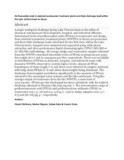Perfluoroalkyl acids in selected wastewater treatment plants and their discharge load within the Lake Victoria basin in Kenya
Date
2015-04-11Author
Chirikona, Florah
Filipovic, Marko
Ooko, Seline
Orata, Francis
Metadata
Show full item recordAbstract
A major ecological challenge facing Lake Victoria basin is the influx of chemical contaminants from domestic, hospital, and industrial effluents. Determined levels of perfluoroalkyl acids (PFAAs) in wastewater and sludge from selected wastewater treatment plants (WWTPs) in Kenya are presented and their daily discharge loads calculated for the first time within the Lake Victoria basin. Samples were extracted and separated using solid-phase extraction and ultra-performance liquid chromatography (UPLC)-MS/MS or LC-MS/MS methodology. All sewage sludge and wastewater samples obtained from the WWTPs contained detectable levels of PFAAs in picogram per gram dry weight (d.w.) and in nanogram per liter, respectively. There was variability in distribution of PFAAs in domestic, hospital, and industrial waste with domestic WWPTs observed to contain higher levels. Almost all PFAA homologues of chain length C-6 and above were detected in samples analyzed, with long-chain PFAAs (C-8 and above chain length) being dominant. The discharge from hospital contributes significantly to the amounts of PFAAs released to the municipal water systems and the lake catchment. Using the average output of wastewater from the five WWTPs, a mass load of 1013 mg day−1 PFAAs per day discharged has been calculated, with the highest discharge obtained at Kisumu City (656 mg day−1). The concentration range of perfluorooctanoic acid (PFOA) and perfluorooctane sulfonate (PFOS) in wastewater was 1.3–28 and 0.9–9.8 ng L−1 and in sludge samples were 117–673 and 98–683 pg g−1, respectively.
URI
https://doi.org/10.1007/S10661-015-4425-6https://link.springer.com/article/10.1007/s10661-015-4425-6
http://r-library.mmust.ac.ke/123456789/1657
Collections
- Gold Collection [1026]

